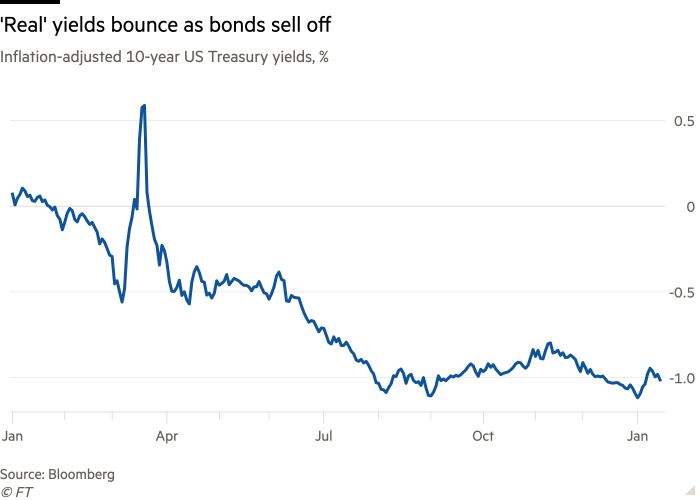Inflation-adjusted US bond yields push higher from record low

Roula Khalaf, Editor of the FT, selects her favourite stories in this weekly newsletter.
The prospect of another major fiscal boost for the US economy has sparked a January sell-off in government bond markets, as investors recalibrate their expectations for growth and inflation.
The selling began in earnest following two run-off Senate elections that paved the way for president-elect Joe Biden’s economic spending plans, which analysts expect to feed through to faster price rises. As investors moved out of the debt, 10-year Treasury yields reached levels not seen since the start of the coronavirus crisis.
So-called real yields on Treasuries — a measure of the returns investors can expect once inflation is taken into account — have also been dragged higher. From a record low of minus 1.12 per cent on the first trading day of the year, these yields rose to briefly edge above minus 0.95 per cent.
The partial reversal has implications for a range of assets: a dramatic decline in inflation-adjusted yields last year drove a record run in other assets such as gold, dubbed the “everything rally”.
Renewed demand for Treasuries saw real yields hovering at minus 1 per cent on Friday. But analysts predict the upward trend will continue in the coming months.
“We do expect real yields to move higher, but not in a taper tantrum-type fashion,” said Leslie Falconio, senior fixed-income strategist at UBS Global Wealth Management, alluding to events in 2013, when financial conditions tightened sharply after the Federal Reserve suggested it would consider tightening monetary policy.
Concerns about a repeat of the episode have grown since the start of the year, after some regional Fed presidents raised the prospect of reducing the central bank’s bond-buying programme as early as this year.
Other central bank officials, including chairman Jay Powell and vice-chairman Richard Clarida, have since pushed back on the timing, assuring investors that the Fed has no intention of withdrawing its support anytime soon.
“The central bank will let real yields rise so long as it reflects a genuine and convincing improvement in the growth outlook and the move is relatively slow and smooth,” said Chiara Cremonesi, deputy head of fixed income strategy at UniCredit.
“If that is not the case and the increase in real yields leads to a tightening of financial conditions or to an increase in volatility in financial markets, then the Fed will likely do something to counterbalance that increase.”
Comments